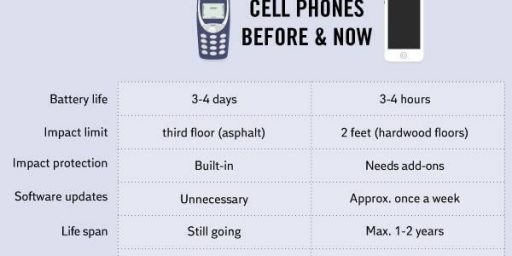Paradox of Choice Paradoxically Untrue
Tyler Cowen dubs the paradox of choice — the idea that people become unhappy when given too many choices — “one of the most overrated and incorrectly cited results in the social sciences.” He cites Tim Harford‘s recent piece in FT describing research on the subject:
Is more choice better? Ten years ago the answer seemed obvious: Yes. Now the conventional wisdom is the opposite: lots of choice makes people less likely to choose anything, and less happy when they do choose.
The most famous supporting evidence is an experiment conducted by two psychologists, Mark Lepper and Sheena Iyengar. They set up a jam-tasting stall in a posh supermarket in California. Sometimes they offered six varieties of jam, at other times 24; jam tasters were then offered a voucher to buy jam at a discount.
The bigger display attracted more customers but very few of them actually bought jam. The display that offered less choice made many more sales — in fact, only 3 per cent of jam tasters at the 24-flavour stand used their discount voucher, versus 30 per cent at the six-flavour stand. This is an astonishingly strong effect — and utterly counter to mainstream economic theory.
[…]
But a more fundamental objection to the “choice is bad” thesis is that the psychological effect may not actually exist at all. It is hard to find much evidence that retailers are ferociously simplifying their offerings in an effort to boost sales. Starbucks boasts about its “87,000 drink combinations”; supermarkets are packed with options. This suggests that “choice demotivates” is not a universal human truth, but an effect that emerges under special circumstances.
Benjamin Scheibehenne, a psychologist at the University of Basel, was thinking along these lines when he decided (with Peter Todd and, later, Rainer Greifeneder) to design a range of experiments to figure out when choice demotivates, and when it does not.
But a curious thing happened almost immediately. They began by trying to replicate some classic experiments — such as the jam study, and a similar one with luxury chocolates. They couldn’t find any sign of the “choice is bad” effect. Neither the original Lepper-Iyengar experiments nor the new study appears to be at fault: the results are just different and we don’t know why.
When I saw that question at Kevin Drum‘s place, the likely answer struck me as rather obvious. Apparently, Kevin though so, too, since he came up with the same answer:
Perhaps the paradox of choice used to be true in simpler times, but the internet and the rest of modern life have taught us to revel in choice, rather than being intimidated by it. In a related vein, maybe it’s a generational thing. Maybe choice dazzles me more than it does a 20-something who grew up with 87 cell phone plans, 300 cable channels, and 1,000 Facebook friends.
Even aside from technology, we’re used to more choices. Yes, we’ve gone from 3 TV channels to hundreds but also from 3 or 4 car manufacturers to a dozen, an almost infinite variety of coffees, ethnic restaurants, and many other things over the course of the past few years.
Kevin’s also right, I think, that our familiarity with the product in question matters. It’s a bit of a chore to chose between seventeen brands of strawberry jam, for instance, but not all that complicated. On the other hand, choosing a cell phone and accompanying plan — and being obligated for two years to live with that choice or pay heavy penalties — can be rather intimidating.
It also occurs to me that the original experiment may just demonstrate that people aren’t interested enough in jam to spend a lot of time comparison shopping. So, unless they’ve run out and really need some more, they may bypass a giant display whereas choosing between, say, strawberry, grape, and cherry and then between Smuckers, Polander, and store brand makes impulse purchases more inviting.
Photo: Country Living






I wonder if there might have been a “geographical” component. Where were the stands located in the stores. Were they in the same spot on different days? Same day of the week?
As purely an anecdotal matter, I found the discussion and prospect of six or twenty-four varieties of jam so boring and uninteresting, I could barely force myself to continue reading.
I wonder if the reaction would be different with a variety of single malt scotches?
(Part of the issue here might be whether the product is being purchased for one’s own consumption, as opposed to the household. One may not be as interested in optimizing purchases that are for more than yourself)
I think somebody did the original study with ice cream as well, with significant differences in satisfaction (fewer choices = more satisfaction).
Whether ice cream or scotch, I think the reasoning is that you might feel like you missed out on something else if there were 100 choices and you can only pick 1.
Given a choice between regular old vanilla, strawberry, and chocolate ice cream, I’ll choose chocolate and be happy every time, because I know that even shitty chocolate ice cream is better than those other two flavors. But what if there was also Moose Tracks and mint chocolate chip available? Now how do I choose?
Ice cream seems like a better case. Interesting to compare this with Malcolm Gladwell’s claim that when there was only one kind of spaghetti sauce, everybody was unhappy because there wasn’t a single ideal flavor, but at least three nodules of preferred flavors (spicy, chunky and tangy IIRC). Obviously we’re dealing with degrees of choice. If you have your flavor, you may not like having to sort for it. If you don’t think there is much difference (my feeling about shaving cream), the choices seem silly and arbitrary, but I can’t imagine them making one anxious.
Hi folks,
Jam, who cares, if you are busy, why bother. If they had a display two aisles over with Wisonsin organic raspberry jam as the sole item, there probably would have been folks that would “take a shot”.
In order for this to pass “muster”, I think bigger ticket items would need to be part of the analysis. Say PCs or washer/dryers, for example.
However, as I have contemplated this, I was fully prepared to argue full choice. However my own personal experience with food does not.
We have a roadside store in N. Michigan, orchard country, that has a basic Cherry pie which is sold in season. They also sell other pies thru the summer, etc. But, once you eat that basic spectacular cherry pie, you may buy, in a weak moment, one of the other offerings, blueberry, etc., after which you will never stray away again since the cherry pie is so awesome. Hence, I am ok with one choice.
I commend the author for this post as the nuances here are real/wide ranging and there is no simple answer.
I am Ghostzapper.
I think it depends on the way choice is being accessed.
For example, if you can see all your choices (like the jams on shelves)it may affect you differently than if you have 10,000 web pages to choose from (e.g. a google search.)
It is a well known axiom in the wireless gaming community that if you are not one of the first on the “deck” (i.e. the menu on a cellphone), forget about getting significant hits to your gaming site , no matter how good the game might be.
Or a more prosaic example, having to choose from one of the many girls at “sauna 117” in Macau!! (too much choice can result in mind numbing deliberation.)
I think this really hits just about every decision — too many choices often makes a reasonably simple decision far too complicated for the eventual reward.
As a large man (with large appetites), I am too large for most cars, which simplified my car buying decision enormously — go from one dealership to the next, find out what I fit in, and then pick from those 4.
Had I not been able to chop the option set down to something manageable by a real requirement, it would have been “which ones have a pretty shade of blue?”
While location is important in merchandizing, at least according to Paco Underhill via books like Why We Buy. I found it interesting that a tight spot with bumping by passers by would cause buyers to move on.
However, I suspect that the problem with the first experiment was the tasting. How many people can taste 24 varieties and remember the earlier one they liked best. It would take several rounds. But people can keep 6 varieties straight in a single round of tasting. Being unsure of what you liked best would inhibit purchases.
The trick is to offer variety to attract browsers but keep the choosing process simple. Something cell phone companies decidedly do not do.
Hah! I went thru this exact situation 2 weeks ago. I walked in, said, “I want a phone, no camera, no games, just a phone.”
“Well sir, all our phones have cameras and games…”
“I am f*ck*d,” I said.
They smiled understandingly and processed me thru.
What ever happened to my choice?
Hmmm. Paradox of Choice = Buridan’s Ass to the umpteenth?
Heh. About 4-5 years ago, the wife and I signed up for a plan and got our phones. The plan ended, but we’ve continued to use the phones, pay the monthly, etc. No contract. About every six months, the company calls and pitches a plan. “Sure,” I always say, “send me the paperwork.” Said paperwork arrives, goes right into the circular file, and we go right on using our phones. The only reason we’d sign up for a plan would be to get new phones. But the goddamned things look so complicated now, and our current phones are perfectly adequate to our needs, we just go right on…
Maybe when people tried 24 different types of jam they were just so totally full and sick of jam that they felt no need to buy any, coupon or no coupon. I know I’ve cut my bar tab at places that offer beer tastes by “tasting” several of the beers before actually ordering one. In fact, all of those “tastes” ended up being two 12 ouncers before I ordered. Nothing like gaming the system.